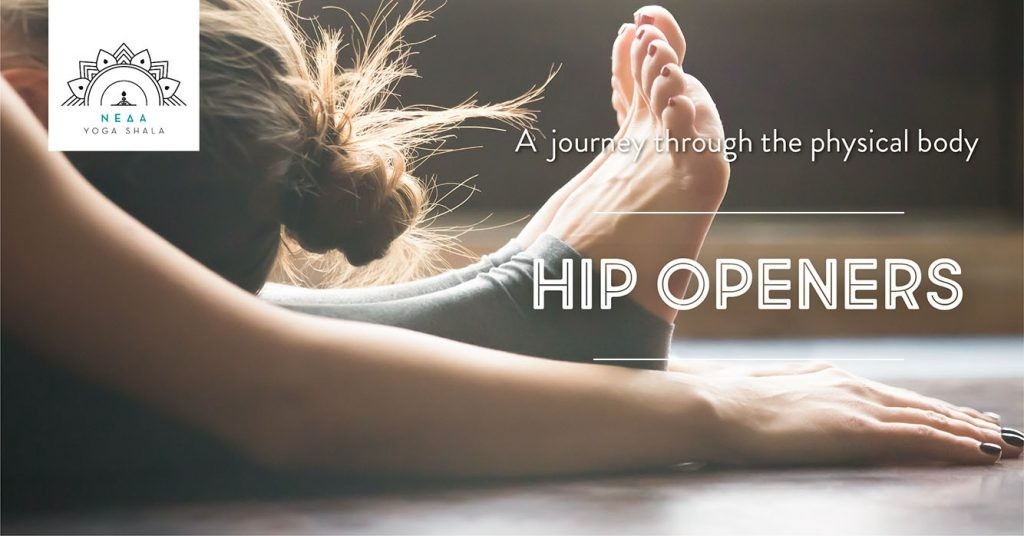
Hip Openers
The “hip openers” refer to one of the most common asana categories in a yoga class. For some of us they are a beautiful refuge, while for others they present a constant challenge. In both cases, the benefits of healthy hips are very important and they extend way beyond the hip joint.
Yes, but… what exactly is a “hip opener”?
The hip joint is where the head of the femur, the shape of which resembles a sphere, attaches to the pelvis, at a cavity called “acetabulum”.
There are approximately 22 muscles that hug this joint and help with the various movements of the leg. Any motion that stretches even a single one of these muscles is considered a “hip opener”. So, an examination of yoga poses would lead us to say that most of them (even a bridge pose or a lying twist) involve a hip opener.
Why are hip openers so important?
Good hip joint mobility makes many of our daily activities easier, from bending to sitting down, to playing with our children or our dog etc. Lack of stability at this part of the body can affect other joints, like the knee or foot joint.
Most importantly though, the muscles that affect the hip are crucial to the mobility and stability of the lower back. Without downgrading the importance of strong back and abdominal muscles, the bigger the range of motion the hips have, the less effort is required from the lower back.
The physical benefits of healthy hips are not limited to the musculoskeletal system. Blood vessels and lymphatic vessels are incorporated into our muscles. A stiff muscle will resist the circulation of these vital fluids, hinderring the function of other systems, such as the digestive system, the immune system, the reproductive system etc. Our body is a constant reminder that nothing works in isolation… everything is interconnected in an incredibly sophisticated way.
In yoga, it is often mentioned that hips are the storage of negative feelings. Just as we store stress on our shoulders and neck, we store fear in the hips: Since we were little, one of the basic instinctive reactions in fear is to pull our knees to our chest and get into a fetal position. Also, when we cry, we tend to curl up. We often assume this positioning during sleep, because it makes us feel safe. In the same way that we clench our fists when we get angry, or our jaws when we are stressed. The hip muscles are the ones pulling the legs in, and they become accustomed to tighten up in the face of any stressful situation, without ever fully relaxing. This way, they entrap a permanent muscular and emotional tension, putting the body into a constant state of alertness.Whether it is about one traumatic event or many less significant events, the feelings of fear, anxiety and sorrow are stored in the hips, until we bring them to the surface, allowing them to be released. The more these feelings are suppressed, the more they get anchored inside the body. This is one of the reasons why for many of us, these exercises are emotionally charged.
Obviously, by elongating our leg muscles we do not solve external life problems. But it does help us to stop carrying them all the time, like a heavy sac on our backs. As Dr Georg Feuerstein points out:
The main thing in Yoga is not pain. Is how to overcome suffering. Suffering has to do with how we relate to pain.
By getting rid of these burdens from our hips, we slowly start to create space for new things. It is not by chance that low in the pelvis is located our second energy center (Swadisthana Chakra), the center related to creativity, artistic expression and playful attitude.
In Hatha Yoga practice there is often a tendency towards strong muscle flexibility. While flexibility is very important, it should be accompanied by muscle strengthening, so that the joint remains stabilized and safe.
The structural limits of each body must also be respected. A simple x-ray comparison demonstrates how great the differences are between two people when it comes to joint shapes (e.g. the curvature or the length of the head of the femur). This means, that it is crucial to accept that some of the more extreme poses in yoga are simply not safe or impossible to be performed by everyone.
It is always helpful to think that the practice of yoga is not about how much we are able to stretch a muscle, but about being calm and aware while we stretch, even if the stretch is small. Hip openers are a tool to connect to our inner being. Yoga has less to do with accumulation and more with the simplicity and the deconstruction of a process. Many of the muscles that hug the hip are big. Combined with the emotional burden they carry, the body often becomes afraid, it reacts and it tenses. To understand and stretch them requires time and patience. In the process, we start to cultivate less appreciation for the destination and more for the journey inside the body and through the body.
Happy exploring!